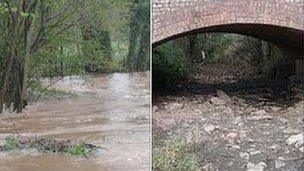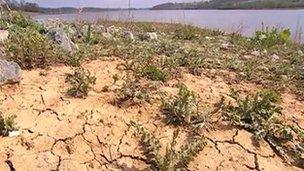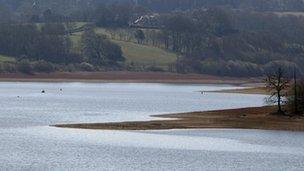Drought challenges around England despite wet weather
- Published
While environmental experts try to solve the problem of drought in areas across England many have had to cope with too much water after recent heavy rainfall led to scores of flood alerts.
But despite the wet weather, much of the country remains in an officially dry state.
It has been suggested that England could see standpipes in the street next year if the country goes through a third dry winter.
But with some areas more badly affected than others what are the challenges being faced?
Hampshire and Berkshire

Chalk streams provide a unique habitat for insects, fish, plants, crayfish, birds and mammals
In the south of England chalk streams provide much of the water for the local population.
However, the rivers are classed as "over-abstracted" by the Environment Agency (EA) with many running dry as the growing demand for water disrupts the rivers' natural ability to cope with drought.
Chalk streams provide a unique habitat for insects, fish, plants, crayfish, birds and mammals like the water vole and otter.
And some people are worried about one proposal to move water around to where it is needed.
Rod Murchie, from the EA, said: "There's talk of a national grid of water, for example moving water through the canal system.
"But if we move water from Wales - slightly acidic water from Wales - it will destroy the river."
Herefordshire

A two-mile section of the River Dore dried up six months ago
Part of the River Dore ran dry six months ago although recent rainfall has seen localised flooding.
But despite the heavy rainfall experts warn it may not be enough to stop it drying out again.
Robert Denny, of Monnow Rivers Association, said: "It's quite possible to get a dry river bed again in October.
"In general this rain will do some good, but it's not long term.
"We could be down to summer levels and serious drought conditions in a few weeks if rain stops."
East Midlands

Lagoons are being used to control water levels in Rutland Water
Low water levels are causing concern for those who manage wildlife reserves in the East Midlands.
The Environment Agency said Derbyshire, Nottinghamshire and Leicestershire were at high risk of drought.
Tim Appleton, reserve manager at Rutland Water, said he was concerned that the dry conditions could mean a return to the situation in 1989 when large areas of the reservoir dried up.
He added the reserve was managing water levels by moving water in and out of the main reservoir from a series of lagoons - which helps safeguard the wildlife in the area.
"We can release water and allow it to flow from one lagoon to another. The water also flows away from the lagoons back into the reservoir," he said.
Sussex, Kent, Hampshire and the Isle of Wight

Bewl Water reservoir is currently 60% full when it would normally be 90% full at this time of year
In the South East one water company has pledged to meet its leakage targets after it was revealed last year it wasted an average of 96 million litres a day through leaks.
Southern Water was told by water regulator Ofwat to return £5m to its customers for failing to deliver leakage reduction targets.
Director of communications Geoff Loader said there would always be leaks but it was working hard to find and fix them.
He said: "Quite clearly we can't go leaking water and not managing that situation and then ask customers to save water, that would simply be wrong.
"I guarantee we'll come in well below that target when the new targets are set."
Last week Green Party leader Caroline Lucas criticised the company for wasting so much water, and called on it to invest some of its profits in dealing with the issue.
Much of southern and eastern England has been officially in a state of drought since February with reservoir and aquifer levels well below average.
- Published2 May 2012
- Published2 May 2012
- Published2 May 2012
- Published2 May 2012
- Published2 May 2012